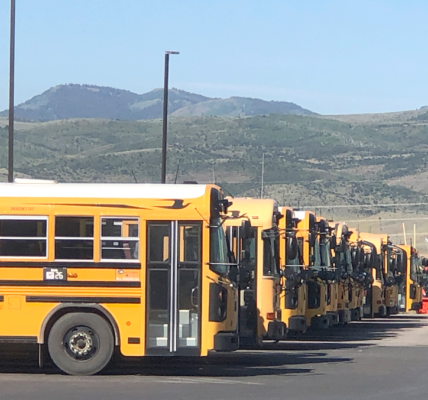Uncertain future: Local school superintendents share thoughts on U.S. Department of Education
By Hector Martinez
The Sheridan Press
Via- Wyoming News Exchange
SHERIDAN — President-elect Donald Trump’s Agenda 47 campaign pledged to close the Department of Education in Washington, D.C., in an effort to send all education work back to the states.
Although eliminating the department would not only require congressional approval but also a supermajority of 60 votes in the Senate, according to a Washington Post article, local school superintendents recently shared their thoughts on the possible future of education.
“It would take time. This is not something that immediately would take place, even if Congress were to vote to basically dissolve the department,” Sheridan County School District 2 Superintendent Scott Stults said. “I don’t believe that the suggestion is that not only you dissolve the Department of Education, but you also dissolve the money and the money doesn’t go to education. I think the premise behind that is that there should be more local control of where that money goes. I’m always a proponent of local control.”
What is Agenda 47?
Agenda 47 is a collection of formal policy plans of Trump, many of which would rely on executive orders and significantly expanded executive power in order to be executed, according to USA Today.
“We want (the states) to run the education of our children because they’ll do a much better job of it. You can’t do worse,” Trump said in an Agenda 47 September 2023 video, which was posted on his platform page. “We’re going to end education coming out of Washington, D.C.,…. We’re going to send it all back to the states.”
In the September 2023 video, Trump announced his 10 educational principles for Agenda 47, which included project-based learning, freedom to pray in school, universal school choice and other principles shared on his platform page.
Trump also announced he plans to cut federal funding for any school or program pushing critical race theory, gender ideology or “other inappropriate racial, sexual or political content onto our children,” in his January 2023 video regarding education.
Established in 1980, the U.S. Department of Education’s mission is to promote student achievement and preparation for global competitiveness by fostering educational excellence and ensuring equal access.
The department establishes policies relating to federal financial aid for education, administers distribution of those funds and monitors their use. It also enforces federal statutes prohibiting discrimination in programs and activities receiving federal funds and ensures equal access to education for every individual, according to its website.
The department has no say in developing curriculum, determining requirements for enrollment and graduation, and much of the structure of education finance in the U.S. reflects the primary state and local role, according to the department’s website.
Superintendents share thoughts
Sheridan County School District 1 Superintendent Jeff Jones said he was open to the idea of localizing control of educational decisions.
“This ‘help’ over the last century (from the DOE) has turned into one-size-fits-all mandates for all schools across the country. We have more than enough information at our fingertips in 2024 to know what does and doesn’t work in education. We also have ways to access new information that doesn’t involve traveling in a horse and buggy,” Jones said in an email to The Sheridan Press. “I am much more confident in the people in our state and local communities knowing what is best for students in our school district than those working in Washington D.C.”
Sheridan County School District 3 Superintendent Chase Christensen said he could see a situation where the department could go away and the states would then be granted the funding streams to decide how and where to allocate them.
What concerns Christensen on potentially seeing funding streams move from the federal level to the state level is the possibility of allocation on a per pupil basis, he said.
“As the smallest district in the state, I often see situations where, when we’re funded on a per pupil basis, the dollars just don’t add up to be enough that they’re able to make the difference that we would hope that they do,” Christensen said.
Stults said there can be some advantages to local and state control on federal money, if the department were to be removed and the money were to go directly to the states.
“If money is given, then there needs to be expectations as to what that should look like and how it should be spent, and there should be some guidance in regards to that,” Stults said. “If the U.S. Department of Education goes away, the money goes directly to the states and the money is still there as far as quantity or more, and then the state gets to dictate how that works and we have some say in that? I think there’s some advantages to that because we know where the money would be best spent and how it would have the greatest impact on student learning.”
Fremont County School District 6 Superintendent Troy Zickefoose said although he is anxious about the proposed changes, he does not feel fearful.
“For me, if it helps eliminate some bureaucracy and some of the requirements, the burdens that are put on districts, I’m game to see what happens. It does make people nervous, but the path that we’re on right now just doesn’t seem as beneficial as it could be. I think there’s some things that can be done to streamline things,” Zickefoose said. “The consolidated grant — which is Title I, Title II, Title III — it is anything but consolidated. It’s numerous mini grants piled into one program. So if some things like that could be addressed and streamlined, give the money to the state or to districts and then let them decide how best to spend it, instead of all the stipulations (and) requirements, I’m game to see what happens.”
Ultimately, Christensen said schools need to continue to meet diverse needs.
“We’re going to continue to see students that need to be prepared in different ways for the workforce and meeting them where they’re at and making sure that they’re ready for the future is going to take some preparation on our part,” Christensen said.





